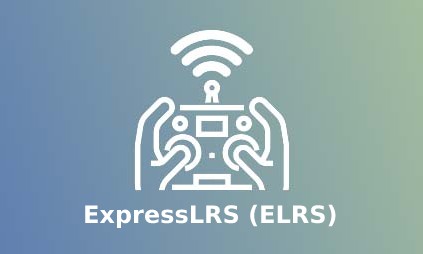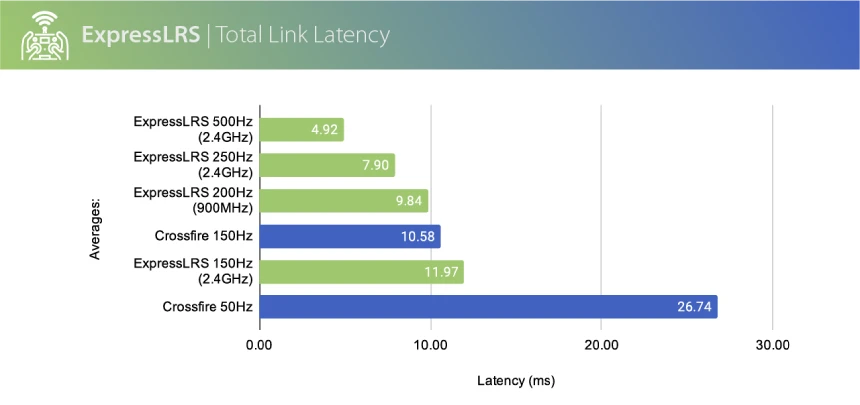
What is ExpressLRS, Best Long Range FPV System? Better than Crossfire?
 ExpressLRS is an open source long-range RC system that focuses on range and latency, developed in 2021. It is also much more cost-effective compared to TBS Crossfire and Tracer. If you're looking for an affordable yet high-performance and reliable radio connection that offers decent range, check out our ExpressLRS article.
ExpressLRS is an open source long-range RC system that focuses on range and latency, developed in 2021. It is also much more cost-effective compared to TBS Crossfire and Tracer. If you're looking for an affordable yet high-performance and reliable radio connection that offers decent range, check out our ExpressLRS article.
What is ExpressLRS (ELRS)?
Feature Rich – ExpressLRS is a modern RC system that offers most if not all the features FPV pilots ever need.
Long Range – Tests have shown it’s possible to get tens of kilometres of range with just 100mW using ELRS, for most ordinary users it just means you will almost never failsafe under normal condition. ExpressLRS is based on SX127x hardware combined with an ESP8285, ESP32 or STM32 MCU for RX and TX respectively. It’s using LoRa modulation in all packet rates, which is also used in ImmersionRC Ghost and TBS Crossfire, that’s why it has noticeably better range than systems that aren’t using LoRa such as TBS Tracer. Note that Crossfire only uses LoRa in 50Hz, when you switch to 150Hz it uses FSK and it doesn’t offer the same great range of LoRa.
Is it better than other more expensive systems?
The system works on 2.4Ghz and 900Mhz frequencies and the furthest we've seen it tested was 40km using 900Mhz at just 10mW as they show on their Github page a table of the distances that testers have reached with a different setting:
| Max Dist. | Freq | Pkt Rate | TX Power | Failsafe at Max Range? | Pilot Handle | Link to DVR |
|---|---|---|---|---|---|---|
| 40Km | 900M | 50HZ | 10mW | No | Snipes | https://www.youtube.com/watch?v=0QWN9qWoSYY |
| 35Km | 2.4G | 250HZ | 100mW | No | Snipes | https://youtu.be/dBmTRhgVcyY |
| 20Km | 2.4G | 150HZ | 100mW | Yes | Pairan | https://youtu.be/B9-AItJ9WS0 |
| 10Km | 2.4G | 500HZ | 10mW | Yes | mrscythe | https://youtu.be/IpiPEZrCGtg |
| 10Km | 2.4G | 250HZ | 100mW | No | Snipes | https://youtu.be/dJYfWLtXVg8 |
| 6Km | 900M | 100HZ | 50mW | No | Snipes | https://youtu.be/kN89mINbmQc?t=58 |
| 6Km | 2.4G | 500HZ | 250mW | No | Spec | https://www.youtube.com/watch?v=bVJaiqJq8gY |
| 4.7Km | 900M | 200HZ | 250mW | No | DaBit | https://www.youtube.com/watch?v=k0lY0XwB6Ko |
| 3Km | 2.4G (chip antenna RX) | 500HZ | 100mW | No | Spec | https://www.youtube.com/watch?v=kfa6ugX46n8 |
| 2.28Km | 900M | 50HZ | 10mW | No | Mike Malagoli | https://www.youtube.com/watch?v=qi4OygUAZxA |
Low Latency – The 900MHz version of ExpressLRS runs at a maximum 200Hz update rate, which is higher than Crossfire’s 150Hz. The 2.4GHz version can even run at 500Hz!

Open source – it’s being developed by an active community and being updated regularly. Different vendors can make hardware for it, which means there are more options and availability of receiver and transmitter modules, similar to Betaflight flight controllers.
Affordable – because it’s open source, the software is free so the cost is purely just the hardware. And the competition between manufacturers drives the price down which is great for the consumers.
Relatively easy to setup – TX and RX modules communicate via the standard CRSF serial protocol (Crossfire) for easy use with Betaflight and OpenTX/EdgeTX.
ExpressLRS Github: https://github.com
List with supported hardware: https://www.expresslrs.org/hardware/hardware-selection/
ELRS is great but not for everyone
ExpressLRS is somewhat more technically complex than other RC systems. That’s why I wrote a guide to walk you through all the steps in setting up your ELRS gear for the first time.
It’s an open source project and it’s rapidly evolving, so things might change a lot over time.
Lastly, ELRS only supports up to 12 channels due to the limited bandwidth, so if you need more channels than that, ELRS maybe not for you.
2.4GHz vs 900MHz
There are two frequencies available for ExpressLRS, 900MHz (915/868) and 2.4GHz.
Tests have shown that ELRS 2.4GHz can do 33km of range on only 100mW, so when people tell you 900MHz is better with range, it’s really not a factor unless you are pushing 30Km or more. And your 5.8GHz video link will most likely run out way before your radio link, so that’s that. But surely, the lower frequency 900MHz has better signal penetration and it’s just physics.
Apart from range and penetration, the main difference is that the 900MHz system can only do up to 200Hz update rate, while the 2.4GHz can do up to 500Hz (even up to 1000hz on custom radio hardware). Your quad would feel more responsive and locked in due to the less latency.
Bandwidth is wider on 2.4GHz meaning you can fly with more people at the same time.
2.4GHz antennas are much smaller (2.5 times), especially with PP and EP2 receivers they have those super tiny SMD ceramic antenna, perfect for micro’s and whoops.
With 2.4GHz, you don’t need to worry about which frequency to use. With 900MHz, you have to choose between 868MHz or 915MHz depending on your region because cell towers share the same band. Antennas (length of active element) have to be optimized for that specific frequency as well. This can complicate things if you are someone constantly traveling and flying in different countries.
So to sum it up, if you want the full ExpressLRS experience for racing, freestyle, or just cruising around, you definitely want 2.4GHz.
Telemetry Support
Telemetry is constantly being improved, currently supporting at least 14 types of data, including VBAT, current, downlink/uplink LQ and RSSI.
In summary, these are the best benefits of the ELRS system:
- It’s cheap (open source).
- Compatible with various hardware.
- It’s being developed quickly.
- Micro-size receivers with ceramic antenna (2.4 Ghz).
- Incredible range.
 EN
EN  BG
BG